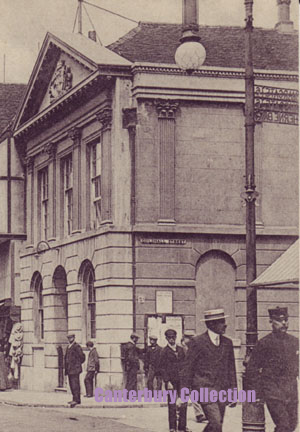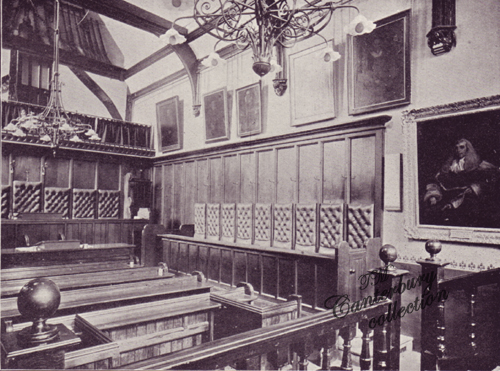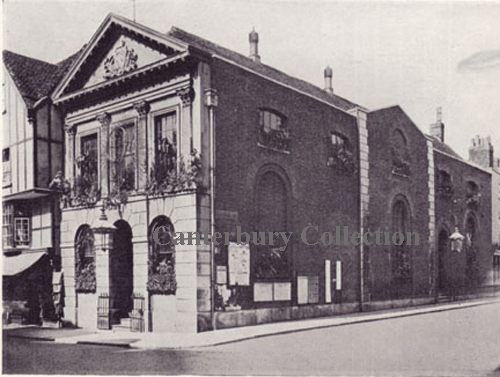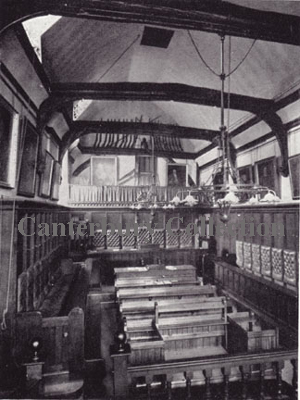
![]()
~ THE GUILDHALL / SPEECH HOUSE ~
CANTERBURY
11 HIGH STREET (torn down in 1952)
*Guildhall beams preserved in the Beaney

"The Guildhall", a detail from one of my old postcards
1608. Sir Thomas White's picture, cost 6l. 11s. 8d. is placed in the Guildhall. HT
1646. The chamberlain is to provide a sufficient hanging, before the town-hall door, for keeping the hall warm, at public meetings. HT
1649. The king's arm, at the Guildhall door, are taken down, and those of the Commonwealth introduced in their stead. HT
1689. Alderman Gibbs is paid 10l. for the painting over the chimney-piece, in the new chamber, and for painting the king's and city's arms in the Guildhall. HT
1709. A large portrait of Queen Ann, cost 10l. is finished by Mr. Thomas Gibbs, and placed in the Guildhall. HT
The picture shows the building "Costa" where the Old Guildhall used to be
The Red Lion Inn, a large building that formerly adjoined the Guildhall, having been pulled down, a new street (called Guildhall street) has been opened from the High-street into Palace street, being the direct road to Margate, Ramsgate, &c. At the entrance of this street stands the side front of the Guildhall, immediately opposite to which a very compact range of buildings have been erected, originally fitted up as an inn and tavern, and called the Guildhall Tavern, for which purpose part is now occupied, and the remainder has been converted into a Bank and other offices. The old established Catch and Glee Club, so frequently visited by strangers passing through Canterbury on Wednesdays is also held under this roof. Near this has lately been erected, a handsome edifice for philosophical purposes, where lectures are given. It contains a library and museum, which are highly creditable to the projectors and members. Ward's Canterbury Guide, 1843

Showing the interior of the Guildhall c. 1910
"....about the middle, on the north side, is the town-hall, a handsome and lofty building, with a spacious gallery over the door, and a stair-case on each side. On the side walls hang some matchlocks, brown-bills, and other old weapons; but the upper end, where the court is kept, is furnished with pictures; a whole length of queen Anne being over the seat of the mayor, and several portraits on each side of it, of persons who have been benefactors to the city. Behind the court is a large and handsome room, where the justices hold their monthly meetings, and some other public business; over it are the archives, where, besides the records and charters, the chamberlain keeps the standards for weights and measures, with the books and accounts of the city business. In this hall, a court of conscience for the recovery of small debts is held every Thursday, and a court of burghmote from time to time. Canterbury being a county in itself, its magistrates have authority to determine all disputes at law between the citizens, and to try for capital offences, committed within the city liberty, the mayor sitting as judge, and pronouncing sentence, assisted by the recorder and bench of aldermen above the chair, who are all justices of the peace."The Kentish Traveller's Companion 1776

March 8th, 1815, an attempt was made to excite a riot at Canterbury, on account of the corn-bill. A number of the lower orders paraded the effigy of a noble earl through the principal streets of the city; and in the evening, having returned to the front of the Guildhall, consigned it to the flames, amidst hootings, hisses, and groans. They then proceeded to acts of violence, by breaking the windows of John Baker, Esq. one of the members of parliament for the city, at St. Stephens; and of Mr. D. J. Parker, at the end of North-lane. The disturbances, however, were speedily quelled, and next day, John Harman, one of the rioters, was committed to gaol, together with his brother Thomas Harman, who had attempted a rescue. The Edinburgh Annual Register for 1815
The guildhall is an ancient and lofty building, containing the various court-rooms for holding the city sessions, and apartments for transacting the business of the corporation; the interior is decorated with portraits of the most distinguished benefactors to the city, and with various pieces of ancient armour. A Topographical Dictionary of England 1831

"The Guildhall, situated in High street at the corner of Guildhall street, was erected in 1439, and re-edified in 1688. It is a handsome building, the front or principal entrance of which consists of a pediment supported by four Corinthian pilasters, on a rustic base. The interior consists of a commodious hall, of antique appearance decorated with pikes, matchblocks, and other weapons of defence, which were taken from Lady Wootton's palace. At the south end is a gallery, and at the north end are several ancient pictures, said to be portraits of Queen Anne, Sir John Boys, and others, benefactors of the city. The council room, which is also used by the sitting magistrates, and the depository of the city archives is at the north end; Petty Sessions are held in this hall on Monday and Thursday, and Court and Quarter Sessions will be held during the year 1848, on January 4th, April 8th, June 28th, and October 21st. The Mayor's Court is but rarely held, nor has it exercised any jurisdiction in civil pleas for upwards of forty years." Directory 1847
The Guildhall at the corner of this street, modernized without, contains some relics of armour, and some curious portraits. That of Cogan, who gave lands in 1657 for the support of 6 clergymen's widows, to the hospital called after him in High Street, is by Jansen, who was long resident at Bridge, about 3 m. from Canterbury. At the N. end of this street is the small district called "Stable gate," which Ethelbert, it is said, assigned to Augustine and his companions before his own conversion. A handbook for Travellers in Kent and Sussex 1858
"The Guild-hall, at the corner of High-street and Guild-hall-street, was built in 1439, and rebuilt in 1697; has been exteriorly modernized; and contains pieces of ancient armour, and some curious portraits." The Imperial Gazetteer of England and Wales, Vol. I. 1872
"The Guildhall or Courthall, situate in High Street and in the parish of St. Mary Bredman, was rebuilt in the reign of Queen Anne, replacing an older building of the year 1437; its walls are decorated with pikes, matchblocks and other ancient arms, taken from Lady Wootton's house in the time of the Commonwealth; it also contains a collection of portraits of former aldermen, eminent men and benefactors of the city and poor of Canterbury, including among others, Sir Thomas White, the founder of St. John's College, Oxford; Elizabeth, widow of the Rev. George Lovejoy M.A. late Fellow of Merton College, Oxford, some time head master of the King's School; Sir John Boys knight: Lord Chief Justice Tenterden: Alderman Barham, the father of the talented author of the "Ingoldsby Legends" (the late Rev. Richard Harris Barham M.A. of Brasenose College, Oxford, minor canon of St. Paul's); Alderman Simmons M.P. who left an endowment for keeping up the terraces and garden of the Dane John; and other Canterbury worthies. About two years ago the whole of the interior was re-arranged and re-decorated." Kelly's Directory of Kent 1882
"The Guildhall or Court-house, until the time of Henry VI. was called the "Spech House," but since that time the Guildhall. In 1437 it is rebuilt. In 1408 the accounts mention a payment for carriage of gunnery from the old chamber to the new chamber, also great repairs done at the old hall, and to the south chamber next the street." (Bunce's Minutes) "It was situate nigh the Lion Inn in High Street, in Canterbury, in the parish of St. Mary, Bredman," and is still a conspicuous building in High Street, rebuilt about the time of Queen Anne. A.D. 1598, a post was set up at the Guildhall door, at which rogues and idle persons were punished. In 1646 the Chamberlain of Canterbury was ordered to provide sufficient hangings or tapestry before the Town Hall door, for keeping the hall warm at public meetings." JB
WTHBH - April 15, 1899 - Canterbury general purposes committee. A meeting of this committee was held in the Guildhall on Wednesday, when there were present the Deputy Mayor (Alderman W. W. Mason) in the chair. Alderman Sanderson, Cross, and Hart. Councillors, Gaskin, Pope, Stead, Hunt, Parker, Dunn, Netherclift, Kennett, Gentry, Godden, Burren and Whichcord.
In 1904 the whole of the interior was re-arranged and re-decorated
COUNTY COURT - 1882
George Russell, Esq. Judge
Walter Furley, Registrar
William Welby, High Baliff *William Welby's been High Bailiff of County Court since at least 1851
William Plant, Chief clerk
Richard Wellard, Hall Keeper
The court is held monthly. The district comprimises the following places: Adisham, Barham, Bekesbourne, Bishopsbourne, Bramling Brideg, Blean, Chartham, Chilham, Chislet, Fordwich, Grove, Hackington (otherwise St. Stephen's), Harbledown, Upper & Lower Hardres, Herne, Herne Bay, Hoath, Icham, Kingstone, Littlebourne, Milton Chapel, Nackington, Patrixbourn, Petham, Reculver, Seasalter, Stodmarsh, Sturry, Swalecliffe, Thanington, Waltham, Westbere, Whitstable, Wickhambreaux & Womenswould.
1889
County Court, this court is held every month (except in September), and days fixed by the Judge, at 10 o'clock, at the Guildhall, for the recovery of debts, &c. The County court of Kent, held at Canterbury, is the Court having jurisdiction under the Bankruptcy Act, 1869, for the Eastern part of Kent.
Judge, His Honour W. Lucius Selfe
Walter Furley, Esq., solicitor, 38 St. Margaret's Street, Registrar
William Welby, High Baliff *William Welby's been High Bailiff of County Court since at least 1851
Wm. Plant, Cheif Clerk
1889 Directory - GUILDHALL AND CITY SESSION HOUSE Richard Wellard, Hall Keeper
1903 Guildhall keeper - Robert Barrett, 66 Burgate Street (also Sherriffs' Officer)
1913 Edward Jarvis, Hall keeper
1917 E. Jarvis, Hall Keeper, Canterbury County Court
Kent Family History Society has a microfiche publication (fiche #164) for the Calendar and Index of General Sessions of the Peace and Goal Delivery held at the Guildhall Canterbury 1751-1759 for the City of Canterbury, by D.Harrington